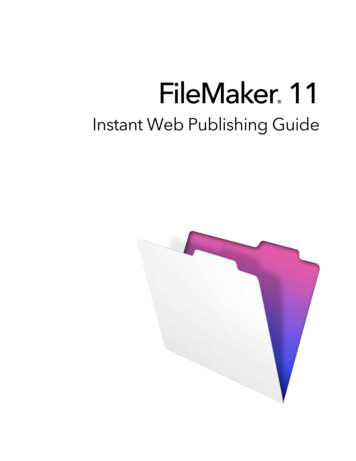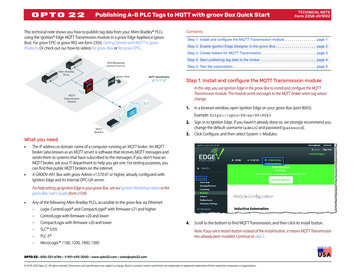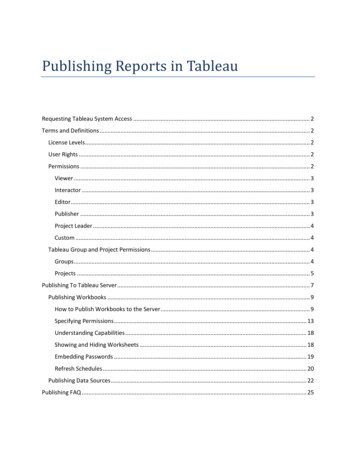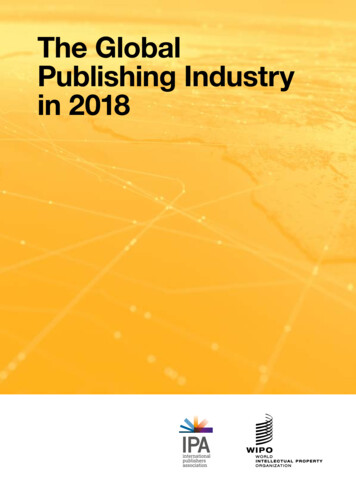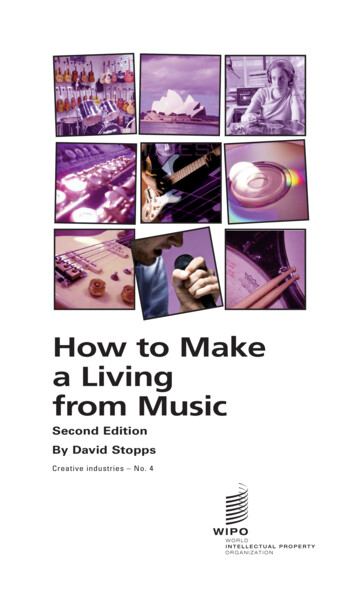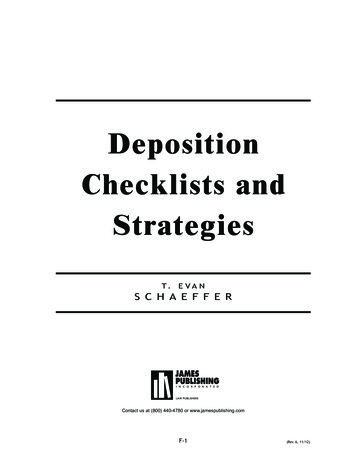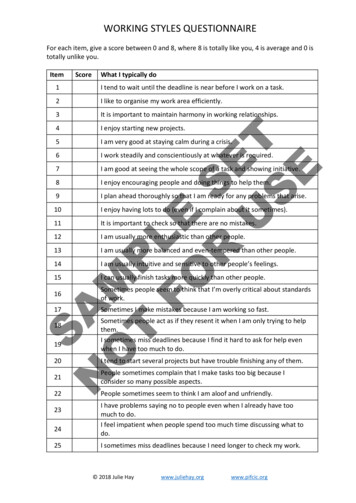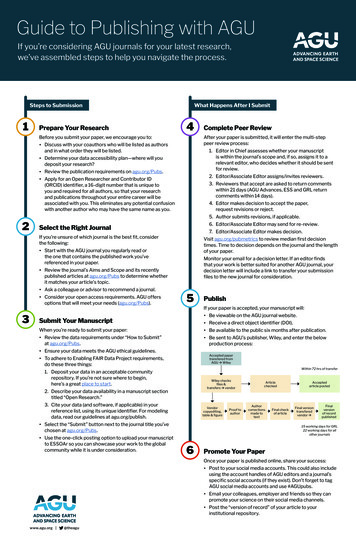
Transcription
Guide to Publishing with AGUIf you’re considering AGU journals for your latest research,we’ve assembled steps to help you navigate the process.Steps to Submission1Prepare Your ResearchWhat Happens After I Submit4Before you submit your paper, we encourage you to: Discuss with your coauthors who will be listed as authorsand in what order they will be listed. Determine your data accessibility plan—where will youdeposit your research? Review the publication requirements on agu.org/Pubs.Complete Peer ReviewAfter your paper is submitted, it will enter the multi-steppeer review process:1. Editor in Chief assesses whether your manuscriptis within the journal’s scope and, if so, assigns it to arelevant editor, who decides whether it should be sentfor review.2. Editor/Associate Editor assigns/invites reviewers.Apply for an Open Researcher and Contributor ID(ORCID) identifier, a 16-digit number that is unique toyou and required for all authors, so that your researchand publications throughout your entire career will beassociated with you. This eliminates any potential confusionwith another author who may have the same name as you.3. Reviewers that accept are asked to return commentswithin 21 days (AGU Advances, ESS and GRL returncomments within 14 days).4. Editor makes decision to accept the paper,request revisions or reject.5. Author submits revisions, if applicable.26. Editor/Associate Editor may send for re-review.Select the Right Journal7. Editor/Associate Editor makes decision.If you’re unsure of which journal is the best fit, considerthe following: 3Visit agu.org/pubmetrics to review median first decisiontimes. Time to decision depends on the journal and the lengthof your paper.Start with the AGU journal you regularly read orthe one that contains the published work you’vereferenced in your paper. Review the journal’s Aims and Scope and its recentlypublished articles at agu.org/Pubs to determine whetherit matches your article’s topic. Ask a colleague or advisor to recommend a journal.Consider your open access requirements. AGU offersoptions that will meet your needs (agu.org/Pubs).Monitor your email for a decision letter. If an editor findsthat your work is better suited for another AGU journal, yourdecision letter will include a link to transfer your submissionfiles to the new journal for consideration.5If your paper is accepted, your manuscript will: Submit Your ManuscriptWhen you’re ready to submit your paper: Review the data requirements under “How to Submit”at agu.org/Pubs. Ensure your data meets the AGU ethical guidelines.Publish3. Cite your data (and software, if applicable) in yourreference list, using its unique identifier. For modelingdata, read our guidelines at agu.org/publish.Use the one-click posting option to upload your manuscriptto ESSOAr so you can showcase your work to the globalcommunity while it is under consideration.Be sent to AGU’s publisher, Wiley, and enter the belowproduction process:Wiley checksfiles &transfers vendor2. Describe your data availability in a manuscript sectiontitled “Open Research.” Be available to the public six months after publication.Within 72 hrs of transfer1. Deposit your data in an acceptable communityrepository. If you’re not sure where to begin,here’s a great place to start.Select the “Submit” button next to the journal title you’vechosen at agu.org/Pubs.Receive a direct object identifier (DOI).Accepted papertransfered fromAGU WileyTo adhere to Enabling FAIR Data Project requirements,do these three things: Be viewable on the AGU journal website.Vendorcopyediting,table & figureProof toauthorArticlecheckedAuthorcorrectionsmade totextFinal checkof articleAcceptedarticle postedFinal versiontransferedvendor Finalversionof recordpublished15 working days for GRL22 working days for allother journals6Promote Your PaperOnce your paper is published online, share your success:www.agu.org @theagu Post to your social media accounts. This could also includeusing the account handles of AGU editors and a journal’sspecific social accounts (if they exist). Don’t forget to tagAGU social media accounts and use #AGUpubs. Email your colleagues, employer and friends so they canpromote your science on their social media channels. Post the “version of record” of your article to yourinstitutional repository.
AGU Journals:The Highest Standards
Make Your Research AccessibleAs a leading publisher in the scientific community, AGU maintains the highest standards and promotesbest practices in scholarly publishing. AGU operates as a not-for-profit publisher with seven openaccess journals. We have more than 100,000 articles in our database, with new ones added regularly.The 22 peer-reviewed journals are driven by editors who are recognized experts and leaders in theirrespective research areas. AGU publications have one of the fastest publication times across all Earthand space science journals, meaning your research can be accessed, read and cited sooner.AGU is a leader and proud supporter of open science, and we seek to make scientific research and itsdissemination accessible to all. Some of the actions we’ve taken to ensure that research published inAGU journals reaches the widest possible audience include: Making all new journals acquired or startedby AGU since 2010 fully open access, whichmeans all articles are freely accessible toread, download and share. Encouraging the submission of plain-language summaries to encourage comprehension of scientific results by the widestpossible readership. Offering free access to 96% of the contentpublished in AGU journals since 1997. Including access to the back files of AGUjournals (via the Digital Library) as an addedbenefit for AGU individual members sinceJanuary 2020.Highlighting selected journal articles in Eosmagazine, which reaches a print audience ofmore than 22,000 people around the world. Founding the Earth and Space ScienceOpen Archive (ESSOAr), a community serverwhere scientists can share early researchincluding preprints and posters presented atmajor scientific meetings.Issuing AGU press releases to highlightjournal articles that feature groundbreakingresearch that may be disseminated morebroadly by the general media. Allowing authors to post the “version ofrecord” of the article to their institutionalrepository; it will be available to the public sixmonths after publication.Joining countrywide “read and publish”deals providing open-access payments forresearchers at institutions in the followingEuropean countries: Austria, Finland,Germany, Hungary, Netherlands, Norway,Sweden and the United Kingdom. Facilitating discounts to open access forthousands of institutions with accounts covering open-access payments for researchers, including new deals with the OhioLINKconsortium in Ohio (118 institutions) and theVIVA consortium in Virginia (57 institutions):agu.org/oafunds. Supporting Research4Life, a program providing free or low-cost access to AGU publications at institutions in low- to middle-income countries. Participating in the Access to Research initiative, which provides free access to patronsof public libraries in the United Kingdom.Make Your Data FAIRFindable, Accessible, Interoperable and Reusable (FAIR) Data standards, which: Ensure the integrity of published research.Facilitate data reuse in future work.Provide more data in repositories so theycan be discovered. Include documentation of data to betterunderstand their purpose and origin. Create a common data experience whensubmitting papers to a journal.
AGU Journal Impact Factors and MetricsAs signatories of the Declaration on Research Assessment (DORA), AGU recognizes that authorswant a more comprehensive assessment of research journals beyond the journal impact factor.To view additional metrics including median days to first decision†, submissions year-to-date andarticles published year-to-date, visit agu.org/pubmetrics.Median Days toFirst Decision†2019Impact Factor‡Five-YearImpact FactorTotal Citationsin Previous YearAGU Advances54***Earth’s Future676.147.062,369Earth and Space Science582.313.32697Geochemistry, Geophysics,Geosystems (G3)513.283.7216,556GeoHealth453.66****Geophysical Research Letters314.504.95107,895Global Biogeochemical Cycles844.615.7414,713JGR: Space Physics422.802.7538,426JGR: Solid Earth563.644.1951,244JGR: Oceans633.563.7438,920JGR: Atmospheres523.824.3574,401JGR: Planets493.713.8610,983JGR: Earth Surface713.564.088,417JGR: Biogeosciences583.414.239,440Journal of Advances inModeling Earth Systems(JAMES)764.334.834,215Paleoceanography andPaleoclimatology622.892.89329Perspectives of Earth andSpace Scientists************Reviews of Geophysics6921.4522.6312,597Radio Science941.311.474,888Space er Resources Research674.315.0456,293JournalFor papers that are sent for review.‡Source: Clarivate Journal Citation Report 2019.*AGU Advances published its first issue in Q1 of 2020.**GeoHealth received its impact factor in June of 2020.***Perspectives of Earth and Space Scientists published its first issue in the first quarter of 2020.†
AGUvideosamericangeophysicalunionAGUWeChat
2. Editor/Associate Editor assigns/invites reviewers. 3. Reviewers that accept are asked to return comments within 21 days (AGU Advances, ESS and GRL return comments within 14 days). 4. Editor makes decision to accept the paper, request revisions or reject. 5. Author submits revisions, if applicable. 6. Editor/Associate Editor may send for re-review. 7. Editor/Associate Editor makes decision.
